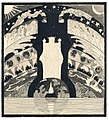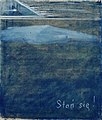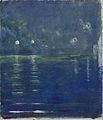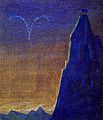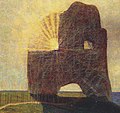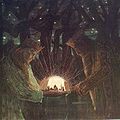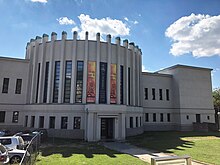Mikalojus Konstantinas Čiurlionis
Mikalojus Konstantinas Čiurlionis (born 10 . Jul / 22. September 1875 greg. In Varėna , † March 28 jul. / 10 April 1911 greg. In Pustelnik ( Marki ) in Warsaw ) was a Lithuanian composer and painter .
Life
Mikalojus Konstantinas Čiurlionis was the oldest of nine children in a Polish-speaking family. His mother Adelė had German ancestors and his father Konstantinas was an organist. Accordingly, he came into contact with music early on. From 1889 to 1893 he received lessons in the orchestra school of the Polish Prince Michał Ogiński in Plungė . The support of the prince enabled him to study music at the Warsaw Music Academy in 1894 in the subjects of piano and composition. Zygmunt Noskowski was one of his teachers . In 1899 he received his diploma. Instead of taking on a permanent position, Čiurlionis decided in 1901/02 to perfect his musical training at the Leipzig Conservatory with Carl Reinecke and Salomon Jadassohn . From 1902 he began to be interested in painting and took his first painting lessons in Warsaw. He saw himself as a synesthete . In addition, he dealt more and more with philosophical questions. György Dalos writes: "The national artist, extremely popular in the USSR [...], as a composer and painter, sought the synthesis of these two types of art." From 1904 to 1906 he was a student at the Warsaw School of Fine Arts. After that, Čiurlionis was very active both compositionally and painterly: he gave concerts and participated in numerous art exhibitions. In 1907/08 he lived in Vilnius . After that he settled in Saint Petersburg . Towards the end of his life he suffered from mental health problems. He was treated in various hospitals, but died at the age of 35 years at a pneumonia . Posthumously he received the greatest recognition in Lithuania. Both his music and his paintings met with a great response. In 1987 a Čiurlionis society was established. Vytautas Landsbergis is considered to be the greatest connoisseur of his work. Today Čiurlionis has the status of a national hero. The Mikalojaus Konstantino Čiurlionio gatvė in Vilnius and the asteroid (2420) Čiurlionis are named after him.
Čiurlionis as a composer
Čiurlionis' work has its roots in late Romanticism . Lush harmonies and enthusiastic soundscapes already characterize his first works. The folk music of his country was also of great importance to him; he collected numerous songs and harmonized them. But Čiurlionis was a very innovative spirit and began to undertake amazing compositional experiments. In this context, the development of composition techniques based on series is very remarkable. Here he anticipated Schönberg's twelve-tone technique without, of course, breaking with the tonality . Nevertheless, his works show an unusually free harmony . Čiurlionis also proved to be very independent in terms of rhythm . He developed very complex rhythmic structures and applied polyrhythmics and even polymetrics . Some of his later works are characterized by strongly pronounced polyphonic structures, which leads to a tendency towards neoclassicism . The focus of his compositional work was piano music. The influence of painting on his music is interesting: many of the works are clearly painted and attempt to depict landscapes musically. His compositions also have a remarkable tonal color. Čiurlionis was the first Lithuanian composer of stature. His works, which were cataloged by Vytautas Landsbergis, are also of international importance.
Čiurlionis as a painter
As a painter, Čiurlionis preferred landscapes, but was also close to symbolism . His pictures often have a philosophical background. The influence of music on painting is again noticeable: Čiurlionis created several cycles of paintings, which he called " sonatas " and whose individual pictures he named " Allegro ", " Andante " and the like. Ä. overwritten. The individual images are based on the character of the respective musical performance instructions: an Andante, for example, conveys a rather calm atmosphere. Some paintings even have the title “ Fugue ”. This synthesis of music and painting is unique in art history. Čiurlionis created around 280 pictures, including 200 paintings and 80 graphics .
Compositions
- Orchestral works
- " Miške " (In the forest), symphonic poem (1900/01)
- "Jūra" (The Sea), symphonic poem (1903-07)
- "Kęstutis", overture (sketches, 1902)
- Vocal music
- "Jūratė", opera (sketches, 1908/09)
- "De profundis", cantata for choir and organ (1899)
- several sacred choirs (1898–1902)
- Choirs and songs
- around 60 folksong arrangements for choir
- Chamber music
- String Quartet in C minor (1901/02)
- Theme and variations for string quartet in B minor (1898)
- Piano music
- Piano Sonata in F major (1898)
- Piano Sonata in C sharp minor (1898, lost)
- "Jūra" (The Sea), cycle (1908)
- Cycles of variation
- 16 cycles of preludes
- Put
- a total of about 200 piano works
- Organ music
- Preludes
- Put
photos
- Spring Sonata (1907)
- Sun Sonata (1907)
- Adder sonata (1908)
- Summer Sonata (1908)
- Sea Sonata (1908)
- Pyramid Sonata (1908)
- Star Sonata (1908)
- Funeral symphony , 7 pictures (1903)
- The creation of the world , 13 pictures (1905/06)
- Zodiac signs , 12 images (1907-09)
- Fir tree joint (1907/08)
- Rex (1908/09)
The development of the REX motif
The creation of the world cycle (Pasaulio sutvėrimas)
13-part picture cycle, tempera on paper approx. 37 × 32 cm, 1905–1906
More works of art
Further reproductions on the website of the Čiurlionis Museum.
literature
- Nijolė Adomavičiene: The world as a great symphony - Mikalojus Konstantinas Čiurlionis , edited by Rainer Budde, Wallraf-Richartz-Museum , Oktogon Verlag, Cologne 1998. ISBN 3-89611-050-0
- Vytautas Landsbergis, Osvaldas Daugelis, Rasa Andrušytė u. a .: Mikalojus Konstantins Čiurlionis - paintings, drafts, thoughts , illustrated book, published by M.-K. Čiurlionis Art Museum, Folio Publishing House, Vilnius 1997. ISBN 9986 33 003 3
- Lama Bialopetravičienė, Wilhelm Lehmbruck Museum : Čiurlionis and Lithuanian Painting 1900-1940 , Duisburg 1989. ISBN 3-923576-57-9
- Heinz Faulstich . Mikalojus Konstantins Čiurlionis - Psychological reflections on his life and work. Dissertation, Tübingen 1953.
- Vytautas Landsbergis: MK Čiurlionis - Time and Content - Biography in English, Vilnius 1992.
- Vytautas Landsbergis: The Royal Conservatory of Leipzig through the eyes of a student, letters from MK Čiurlionis , in: Contributions to Musicology, published by the Association of Composers and Musicologists in the GDR, Issue 1 1979, pages 42-69, Berlin (East) 1979 .
- Zenta Mauriņa : Because the risk is beautiful - the story of a life , section: “Kaunas - breath of infinity”, pages 457-465, Memmingen, Dietrich 1953.
- Gintaras Beresnevičius, Yvonne Luven, Kai Ulrich Müller: Lithuania , Verlag JC Bucher, Munich 1994. ISBN 3-7658-0833-4
Čiurlionis museums
- The National MK Čiurlionis Art Museum in Kaunas, founded in 1921, is one of the oldest and largest art museums in Lithuania and presents the development of Lithuanian and international art from the earliest times to the present. A permanent exhibition is devoted to Čiurlionis' paintings, graphics and photographs.
- The Čiurlionis Memorial Museum set up in Čiurlionis' birthplace in Druskininkai has a permanent exhibition on the life of the artist and changing exhibitions on various topics.
- The Mikalojus Konstantinas Čiurlionis House in Vilnius, which opened on the occasion of the artist's 120th birthday on September 22, 1995 and where the painter and composer lived in 1907/08, hosts chamber concerts and exhibitions as well as conferences and other cultural events. The Čiurlionis company, founded in 1987, is also based here.
Web links
- Page about Čiurlionis - with biography, photos, audio samples and numerous pictures
- Correspondence from Leipzig time PDF file
- Stefana Sabin: Mikalojus Konstantinas Čiurlionis and the neo-romantic fantasy . On the 100th anniversary of death in April 2011. In: faust from February 3, 2011.
- Čiurlionis paintings and prints Website of the Čiurlionis Museum, accessed on September 27, 2018.
- Sheet music and audio files by Mikalojus Konstantinas Čiurlionis in the International Music Score Library Project
Individual evidence
- ^ György Dalos, Farewell Comrades, Verlag CHBeck, Munich 2011, page 133, ISBN 978-3-406-62178-9
- ^ Dataset from the German National Library
- ^ Nacionalinis MK Čiurlionio dailės muziejus
| personal data | |
|---|---|
| SURNAME | Čiurlionis, Mikalojus Konstantinas |
| ALTERNATIVE NAMES | Ciurlionis, Mikalojus Konstantinas; Tschurljanis, Nikolai Konstantinowitsch |
| BRIEF DESCRIPTION | Lithuanian composer and painter |
| DATE OF BIRTH | September 22, 1875 |
| PLACE OF BIRTH | Varėna |
| DATE OF DEATH | April 10, 1911 |
| Place of death | Pustelnik near Warsaw |





